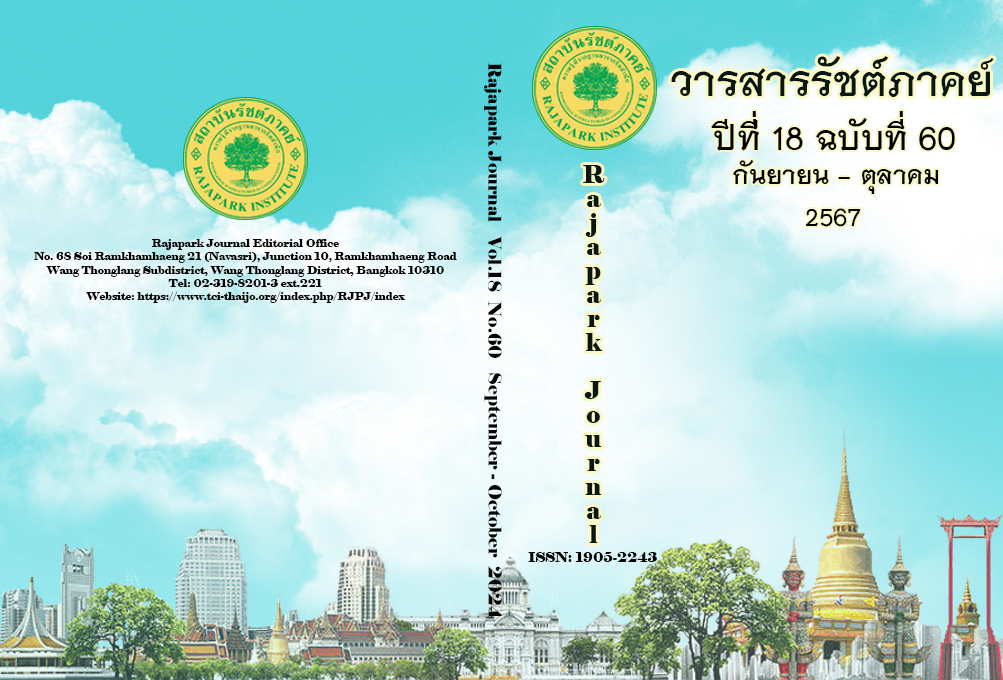Thai Tourists Perceived Value of an Authenticity Management of Chiang Mai International Airport, Thailand: A Proposed Model of an Authenticity Management of Chiang Mai International Airport, Thailand
Main Article Content
Abstract
This research aimed to 1) measure Thai tourists’ levels of the perceived value of authenticity management at Chiang Mai International Airport, Thailand, and 2) construct a model of authenticity management at Chiang Mai International Airport, Thailand. The sample was 400 Thai tourists at Chiang Mai International Airport, Thailand. They were selected by purposive sampling. The instrument for collecting data was a self-administered questionnaire—analysis of data by Descriptive Statistics and Inferential Statistics. The research results were found as follows; 1) Thai tourists with demographic differences had different levels of perceived value of airport attributes displaying Thai Lanna art and culture reference at Chiang Mai International Airport and 2) A model of an authenticity management of Chiang Mai International Airport, Thailand, comprised of 5 levels of perceived value: (1) Functional value; (2) Social value; (3) Emotional value; (4) Epistemic value and (5) Conditional value.
Article Details

This work is licensed under a Creative Commons Attribution-NonCommercial-NoDerivatives 4.0 International License.
Views and opinions appearing in the Journal it is the responsibility of the author of the article, and does not constitute the view and responsibility of the editorial team.
References
Airports of Thailand PLC. (2018). Annual report 2018. https://corporate.airportthai.co.th/wp-content/uploads/2019/03/Annual-Report-2018-en.pdf
Airports of Thailand PLC. (2022). Annual report 2022. https://investor.airportthai.co.th/ar.html
Appold, S. J., & Kasarda, J. D. (2006). The appropriate scale of US airport retail activities. Journal of Air Transport Management, 12(6), 277-287.
Arefi, M. (1999). Non‐place and placelessness as narratives of loss: Rethinking the notion of place. Journal of Urban Design, 4(2), 179-193. DOI: 10.1080/13574809908724445
Beerli, A., & Martı́n, J. D. (2004). Tourists’ characteristics and the perceived image of tourist destinations: A quantitative analysis—a case study of Lanzarote, Spain. Tourism Management, 25(5), 623-636. https://doi.org/10.1016/j.tourman.2003.06.004
Bogicevic, V. (2014). The effect of airport service scape features on traveler anxiety and enjoyment. In W. Yang, A. Bilgihan, & C. Cobanoglu (Eds.), ProQuest Dissertations.
Bogicevic, V., Yang, W., Cobanoglu, C., Bilgihan, A., & Bujisic, M. (2016). Traveler anxiety and enjoyment: The effect of airport environment on traveler’s emotions. Journal of Air Transport Management, 57, 122-129. https://doi.org/10.1016/j.jairtraman.2016.07.019
Chiang Mai World Heritage Initiative Project. (2019). Chiang Mai World Heritage Initiative Project. http://www.chiangmaiworldheritage.net/detail_show.php?id=12&lang=
Fort Lauderdale-Hollywood International Airport. (2017). Terminal design guidelines. http://www.broward.org/Airport/Business/Documents/TerminalDesignGuidelinesUpdate2017small.pdf
Hackett, P., & Foxall, G. (1997). Consumers’ evaluations of an international airport: A facet theoretical approach. The International Review of Retail, Distribution and Consumer Research, 7(4), 333-349. https://doi.org/10.1080/095939697342923
Hansen, M., & Kanafani, A. (1990). Airline hubbing and airport economics in the Pacific market. Transportation Research Part A: General, 24(3), 217-230. https://doi.org/10.1016/0191-2607(90)90059-
FIATA. (2016). Airport Development Reference Manua (ADRM) (10th ed.). https://www.vip-class.ru/userfiles/file/TOCs/adrm10-toc-20161021.pdf
Geiling, N. (2014, Nov 25). Stuck at the Airport? Why Not Take in an Art Exhibit. Smithsonian Institute. https://www.smithsonianmag.com/travel/stuck-airport-why-not-take-art-exhibit-180953432/
Jiang, H., & Zhang, Y. (2016). An assessment of passenger experience at Melbourne Airport. Journal of Air Transport Management, 54, 88-92. DOI: 10.1016/j.jairtraman.2016.04.002
Li, C., Wang, Y., Lv, X., & Li, H. (2021). To buy or not to buy? The effect of time scarcity and travel experience on tourists' impulse buying. Annals of Tourism Research, 86, 103083. DOI: 10.1016/j.annals.2020.103083
Martin, S. R., Marsolais, J., & Rolloff, D. (2009). Visitor perceptions of appropriate management actions across the recreation opportunity spectrum. Journal of Park & Recreation Administration, 27(1), 56-69. https://www.researchgate.net/publication/255546240_Visitor_Perceptions_of_Appropriate_Management_Actions_Across_the_Recreation_Opportunity_Spectrum
Moon, H., Yoon, Hae Jin, & Ha, H. (2015). Role of airport physical environments in the satisfaction generation process: mediating the impact of traveller emotion. Asia Pacific Journal of Tourism Research, 21(2), 1-19. DOI: 10.1080/10941665.2015.1048260
National Academies of Sciences, Engineering, and Medicine. (2010). Airport Passenger Terminal Planning and Design, Volume 1: Guidebook. Washington, DC: The National Academies Press. https://doi.org/10.17226/22964
Patil, D. R. R., & Mamatha P Raj. (2019). The architecture of airport terminals: Gateway to a city. Journal of Creative Space, 7(1), https://doi.org/10.15415/cs.2019.71002
Raturi, R. (2018, 20-21 April 2018). Adapting deep features for scene recognition utilizing places database. In Paper presented at the 2018 Second International Conference on Inventive Communication and Computational Technologies (ICICCT).
DOI: 10.1109/ICICCT.2018.8473136
Sánchez-Fernández, R., & Iniesta-Bonillo, M. Á. (2007). The concept of perceived value: A systematic review of the research. Marketing Theory, 7(4), 427-451. DOI: 10.1177/1470593107083165
Sheth, J., I. Newman, B., & Gross, B. (1991). Why we buy what we buy: A theory of consumption values. Journal of Business Research, 22(2), 159-170. https://doi.org/10.1016/0148- 2963(91)90050-8
Stabler, M. J. (1995). The image of destination regions: Theoretical and empirical aspects. Routledge.
Um, S., & Crompton, J. L. (1990). Attitude determinants in tourism destination choice. Annals of Tourism Research, 17(3), 432-448. https://doi.org/10.1016/0160-7383(90)90008-F
van Oel, C. J., & van den Berkhof, F. W. (2013). Consumer preferences in the design of airport passenger areas. Journal of Environmental Psychology, 36, 280-290. https://doi.org/10.1016/j.jenvp.2013.08.005
Vowles, T. M., & Mertens, D. P. (2005). Airport Niche Marketing: Sanford, Florida's Rise as an International Gateway. Journal of Travel & Tourism Marketing, 17(4), 35-44.
Woodside, A. G., & Lysonski, S. (1989). A general model of traveler destination choice. Journal of Travel Research, 27(4), 8-14. DOI: 10.1177/004728758902700402
Zhang, Y., & Peng, Y. (2014). Understanding travel motivations of Chinese tourists visiting Cairns, Australia. Journal of Hospitality and Tourism Management, 21, 44-53. https://doi.org/10.1016/j.jhtm.2014.07.001


